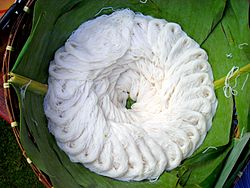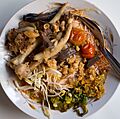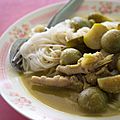Khanom chin facts for kids

Fresh batch of khanom chin
|
|
| Alternative names | khanohm jeen |
|---|---|
| Type | Rice noodles |
| Place of origin | Thailand |
| Region or state | Central Thailand |
| Main ingredients | Rice |
| Similar dishes | num banhchok, mixian |
Khanom chin (Thai: ขนมจีน) are fresh, thin rice noodles from Thai cuisine. They are made from rice that is sometimes left to ferment (change chemically over time) for about three days. After this, the rice is boiled and then pushed through a special sieve into boiling water to form noodles.
You can eat Khanom chin with many kinds of sauces. Some popular choices include coconut milk, fish curry, or spicy chili sauce. Even though the word chin means "Chinese" in Thai, these noodles actually came from the Mon people. The Mon people used to live in the area that is now central Thailand. The name khanom chin might come from the Mon words hanom cin, which means "boiled noodles."
Contents
Popular Khanom Chin Dishes
These noodles are a main food in many Thai meals. Here are some popular ways to enjoy them:
- Khanom chin nam ya: Served with a hot and spicy sauce made from fish.
- Khanom chin nam phrik: Comes with a sweet sauce made from peanuts.
- Khanom chin kaeng kiao wan kai: Served with a delicious green chicken curry.
- Khanom chin nam ngiao: A special dish from northern Thailand. Its sauce contains pork.
- Khanom chin sao nam: This is like a salad with coconut milk, dried ground prawns, and fresh pineapple.
- Khanom chin tai pla: A very spicy soup from southern Thailand.
- Khanom chin miang pla: Noodles served with deep-fried fish and spicy chili sauce, all wrapped in a large salad leaf.
Another great way to eat these noodles is with Thai papaya salad.
Types of Khanom Chin Noodles
There are two main types of khanom chin noodles:
- Fermented Flour Noodles: These are usually made in the northeast of Thailand. The noodles are a bit brown and stickier. They can also last for a longer time. This is the older, traditional way of making khanom chin.
- Fresh Flour Noodles: These noodles are bigger and softer. They are white and easier to make than the fermented kind.
How to Eat Khanom Chin
When you get khanom chin, a special sauce called "stock" is poured over the noodles. Different places in Thailand have their own unique stocks. These can include coconut stock, fish sauce, curry sauce, or spicy chili sauce. Some popular curry sauces are green curry, spicy pork sauce, and sour fish organ soup. For kids, there's even a sweet, non-spicy stock with nuts.
You usually eat Khanom chin with fresh vegetables and pickled items on the side.
- In northern Thailand, you might find pickled cabbage and raw sprouts.
- In central Thailand, common sides include banana blossoms, lentils, cucumbers, sprouts, raw papaya, basil, gotu kola, bitter melon, and morning glory. Sometimes, a half-boiled egg and roasted peppers are also served.
- In the northeast, fresh vegetables like white popinac, climbing wattle, and parsley are popular.
- In the south, you might see parkia, white popinac, olives, and various pickles.
Khanom Chin Variations
Khanom chin nam ya
Khanom chin nam ya means "noodles with fish curry" in Thai. It's a spicy dish, just like many other Thai foods such as Tomyamkung or Somtum. The fish curry sauce, called nam ya, comes from Central Thailand.
To make khanom chin nam ya, you need khanom chin noodles, boiled fish, fish balls, and many spices like dried guinea pepper, salt, galangal, lemongrass, garlic, turmeric, fingerroot, shrimp paste, and shallots. You also need coconut milk, fish sauce, palm sugar, boiled eggs, and fresh vegetables.
First, the dried spices are pounded together. Then, boiled fish and shrimp paste are added and pounded more. Next, coconut milk is heated, and the pounded spices are added. When the coconut milk boils, fish balls are put in, and the dish is seasoned. Finally, the khanom chin noodles are placed in a bowl, the fish curry is poured over them, and it's ready to eat with boiled egg and fresh vegetables.
Khanom chin nam ngiao
Khanom chin nam ngiao is a noodle soup or curry. It comes from the Tai Yai people, who live in parts of Myanmar, China, and northern Thailand. This dish has become very famous in northern Thai cooking. Nam ngiao has a special spicy and tangy (sour) taste.
Khanom chin kai khua
Khanom chin kai khua means "noodles with stir-fried chicken." It's similar to Khanom chin nam ya. However, instead of fish, it uses minced chicken cooked with chili oil. It also includes chicken blood pudding, chopped onion, and coriander. This dish is quite rare to find. It is believed to have come from Portuguese cuisine and is sometimes called Khanom chin Portugal.
Khanom chin Pradok
Khanom chin Pradok is a famous noodle dish from Nakhon Ratchasima Province in Thailand. It's known for its tasty curry, which is made with great care. Ban Pradok is a village that has been making boiled rice noodles for a long time. You can find these noodles in restaurants along the roads in the Ban Khok Phai area. They are often served with other dishes like Pad mi Korat (stir-fried noodles), Som tam (spicy papaya salad), Kai yang (grilled chicken), and desserts.
Khanom chin Lom Sak
Khanom chin Lom Sak is a well-known noodle dish from Lom Sak District in Phetchabun Province, northern Thailand. People there love eating these noodles because their ancestors were from Laos. It's said they eat noodles for all three meals! There are many restaurants serving them. The rice noodles here are colorful, made from different herbs, which makes them very unique.
Similar Noodle Dishes Around the World
Many other countries have noodle dishes that are similar to khanom chin:
- Khao poon is a spicy Lao "rice vermicelli" soup from Laos. It's also found in Thailand, Malaysia, Indonesia, Singapore, and the United States. It's made with minced chicken, fish, or pork and Lao spices like fish sauce, lime leaves, and chilies. Khao poon often comes in two versions: one with coconut milk and one without. It's always served with shredded cabbage, carrots, banana blossoms, and bean sprouts.
- Mohinga is a rice noodle and fish soup from Myanmar, often eaten for breakfast. Its main ingredients include catfish, vermicelli noodles, fish sauce, fish pâté, ginger, and lemongrass. It's a very important part of Myanmar's food culture.
- Bún chả is a Vietnamese dish of grilled pork and noodles that comes from Hanoi. It includes rice vermicelli, grilled fatty pork, and fresh herbs.
- Num banhchok is a popular noodle soup from Cambodia. It has rice noodles topped with a cool fish gravy and fresh raw vegetables like cucumbers, banana blossom, water lily stems, and herbs such as basil and mint.
Images for kids




